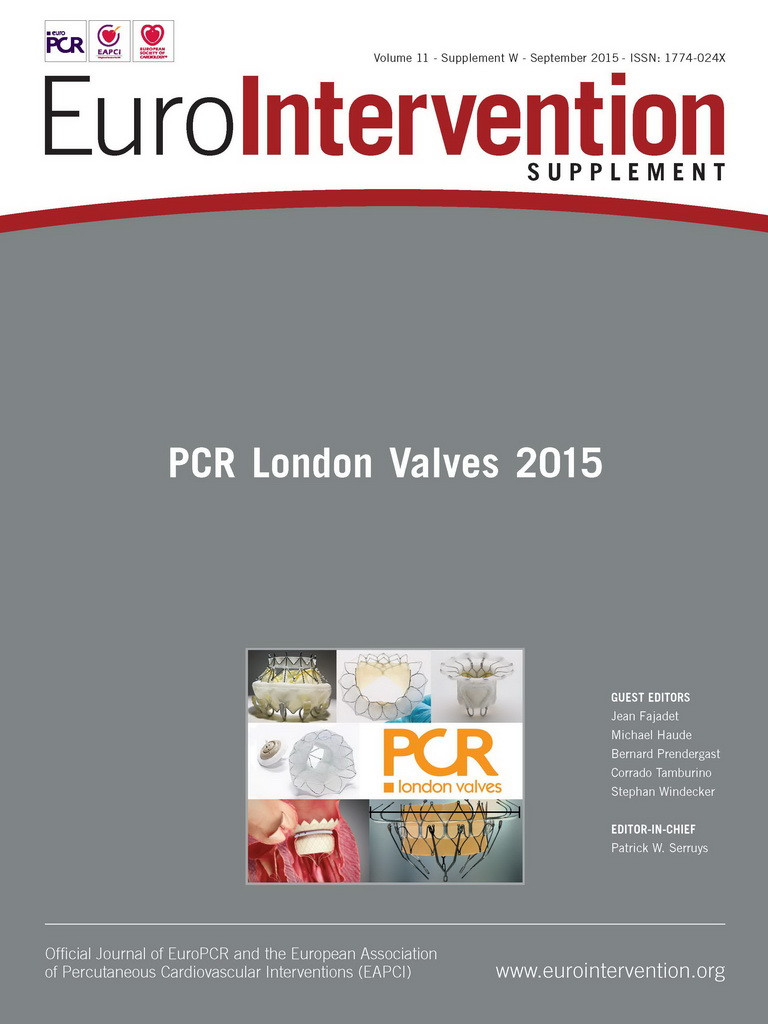Abstract
Surgical treatment of mitral regurgitation has evolved from mitral valve replacement to repair, because the latter produces superior long-term outcomes. In addition, mitral valve repair can be achieved through minimally invasive approaches. The desire for less invasive approaches has driven the field of percutaneous mitral valve repair. Various technologies have emerged and are at different stages of investigation. So far, only the MitraClip device has been tested in large numbers of patients, whereas the reproducibility and the real effectiveness of the other devices still remain to be demonstrated.
In recent years, transcatheter therapies for valvular heart disease have probably represented the most stimulating topic in the field of interventional cardiology. Whilst we may have anticipated that the transcatheter aortic valve implantation (TAVI) technique will soon become the first-line treatment for severe aortic stenosis, even in lower-risk patients, percutaneous therapy for the treatment of mitral regurgitation (MR) is evolving more slowly: it is expected that it will remain reserved for high-risk patients for a long time to come. This remains so despite advances in technology and the fact that our understanding of MR as a clinical and pathophysiologic entity has evolved greatly over the last decade. In fact, the complex anatomy of the mitral valve and mitral apparatus and the interplay of the valve with the left ventricle are the main components causing the greatest difficulty in developing and evaluating mitral devices.
Most percutaneous approaches are modifications of existing surgical approaches. Catheter-based devices mimic these surgical approaches with potentially less procedural risk, due to their less invasive nature. Nowadays, various technologies of transcatheter intervention to treat significant MR have been developed. These approaches can be mainly categorised into leaflet repair, annuloplasty, chordal implantation, and transcatheter mitral valve implantation1. Catheter-based leaflet repair with the MitraClip® (Abbott Vascular, Abbott Park, IL, USA) is accomplished with an implantable clip to reproduce the surgical edge-to-edge leaflet repair technique2. The MitraClip procedure has undergone the most extensive human investigation thus far, with more than 20,000 procedures already performed worldwide. Several other percutaneous approaches have been used successfully in smaller numbers of patients to demonstrate proof of concept, whereas others have failed and are no longer under investigation.
The MitraClip received CE mark approval for general use in Europe in 2008 and FDA approval in the USA in 2013 for the treatment of symptomatic patients with severe primary degenerative MR at prohibitive risk for mitral valve surgery; however, it is not currently approved for secondary functional MR. The MitraClip device requires careful patient selection. Transoesophageal echocardiography is the best tool to assess anatomical suitability for MitraClip implantation, and to guide the procedure in the catheterisation laboratory, along with fluoroscopy. Although this technology was originally designed for degenerative MR, subsequently, in real-world practice, it has been recognised that the MitraClip procedure is more effective in patients with functional MR2. The 2012 European Society of Cardiology/European Association for Cardio-Thoracic Surgery valve and heart failure guidelines provide a Class IIb (level of evidence [LOE] C) recommendation to consider MitraClip use in symptomatic patients with severe secondary MR, despite optimal medical therapy and CRT, who are deemed inoperable or at high surgical risk3. Transcatheter mitral valve repair for secondary MR did not receive an official recommendation in the 2014 ACCF/AHA valvular heart disease guidelines, although it is currently recommended with Class IIb (LOE B) guidance for severe primary MR in symptomatic patients at prohibitive risk for mitral valve surgery4.
As an alternative to the MitraClip technique, novel catheter-based devices have made use of the coronary sinus to achieve indirect annuloplasty, e.g., the CARILLON® Mitral Contour System (Cardiac Dimensions, Inc., Kirkland, WA, USA), which is the second CE marked catheter-based device to address purely functional mitral regurgitation. The limited clinical results with respect to the reduction of MR and improvement of symptoms (NYHA class, 6-minute walking test) are comparable to what has been reported for the MitraClip in patients with functional mitral regurgitation; however, these are not achieved immediately but over the course of the remodelling process which takes place in the six months following the procedure. Although the coronary sinus approach is theoretically a favourable procedure, it has some important limitations. Indeed, the coronary sinus is located variably at a certain distance from the mitral annulus, and circumflex coronary artery compression has been observed in up to 15% of cases. Other devices achieve more direct annuloplasty, thus reproducing surgical annuloplasty more closely (e.g., Mitralign® Percutaneous Annuloplasty System; Mitralign, Tewksbury, MA, USA, and the Cardioband System; Valtech Cardio Ltd, Or Yehuda, Israel). Finally, a different approach to achieve transcatheter leaflet repair in degenerative MR is by off-pump adjustable chordal implantation via a transapical or transseptal approach (NeoChord system; NeoChord, Inc., Eden Prairie, MN, USA).
In conclusion, transcatheter-based techniques for mitral valve repair have evolved greatly in the past decade. However, except for the MitraClip device, the reproducibility and the real effectiveness of most devices is still under investigation. Future clinical trials and observational studies will provide the necessary evidence. Because various transcatheter mitral valve intervention devices will be available in the near future, it is of particular importance to understand how to tailor the right device or strategy to the right patient and clinical setting. Careful patient selection with the Heart Team approach will undoubtedly play a critical role in defining the clinical niche for successful transcatheter interventions.
Conflict of interest statement
C. Grasso is proctor physician for Abbott. The other authors have no conflicts of interest to declare.

